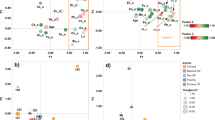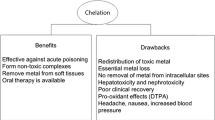Summary
In Japan, industrial health control is accomplished by control of the working environment, work practice management and health care. Periodical biomonitoring of workers exposed to lead and 8 popular organic solvents, including mixed solvents, became mandatory as of October 1, 1989, with an ordinance issued by the Ministry of Labor. This ordinance states that the results of measurements of lead and the 8 solvents in each work place must be classified into 3 categories, named distributions 1, 2 and 3 based on the biological level of the determinant, and then must be reported to the Labor Standards Inspection Office. Distribution 3 encompasses workers having concentration levels above the BEIs of ACGIH except for the concentration of lead in the blood. The National Federation of Industrial Health Organizations surveyed the state of biological monitoring in Japan by a questionnaire to the laboratories. The total number of cases examined in the fiscal year 1990 was about 110,000 for the biomonitoring of lead, and about 520,000 for the monitoring of urinary metabolites of the 8 organic solvents. The ratio of the number of workers in distribution 3 to that of the total workers examined was 0.4 % for urinary delta aminolevulinic acid and 0.2∼3.5 % for the urinary metabolites of each organic solvent. Similar results were obtained from 7 major laboratories. To achieve large-scale biological monitoring in future, a method is necessary for evaluating the exposure or health risks of workers exposed to mixed organic solvents by estimating their urinary metabolites.
Similar content being viewed by others
References
Biological Exposure Indices Committee of ACGIH Biological Exposure Indices, In: Committees in ACGIH (eds) 1991–1992 Threshold limit values and biological exposure indices. ACGIH. Cincinnati, pp 58–70
Chemical Substances TLV Committee (1991) Threshold limit values for mixtures, In: Committees in ACGIH (eds) 1991–1992 Threshold limit values and biological exposure indices. ACGIH. Cincinnati, pp 48–50
German Research Society (1991) Significance and usage of BAT value In: Maximum concentration at workplace and biological tolerance values for working materials. Weinheim, pp 96–98
Engstrom K, Rihimaki V, Laine A (1984) Urinary disposition of ethylbenzene and m-xylene in man following separate and combined exposure. Int Arch Occup Environ Health 54:355–363
Harada H, Ogata M, Inoue N, Kono K (supervised by Industrial Health Division, Labor Standard Bureau, Ministry of Labor) (1990) Method on Health Examination for Workers Exposed to Lead, National Federation of Industrial Health Organizations, Tokyo, pp 81–84
Imbriani M, Ghittori S, Pezzagno G and Capodaglio E (1985) Toluene and styrene in urine as biological exposure indices. Ann Am Conf Hyg 12:351–355
Industrial Health Division, Industrial Safety and Health Department, Labor Standards Bureau and Ministry of Labor (1986) Working environmental measurement system in Japan. Japan, Association for Working Environment Measurement. Tokyo, pp 1–3
Inoue O, Seiji K, Watanabe T, Kasahara M, Nakatsuka H, Yin S-N, Li G-L, Cai S-X. Jin C. Ikeda M (1988) Mutual metabolic suppression between benzene and toluene in man. Int Arch Occup Environ Health 60:15–20
Japan Industrial Safety and Health Association (1983) Industrial Safety and Health Law and related legislation of Japan. Industrial Safety and Health Association, Tokyo, pp 426–499
Kawai T, Yasugi T, Mizunuma K, Horiguchi S, Morioka I, Miyashita K, Uchida Y, Ikeda M (1992) Monitoring of workers exposed to a mixture of toluene, styrene and methanol vapour by means of diffuse air sampling, blood analysis and urinalysis. Int Arch Occup Environ Health 63:429–435
Labor Standard Bureau, Ministry of Labor (1989a) Notification No 462: Implementation of partial amendment of Industrial Safety and Health Law, partial amendment of Prevention of Organic Solvent Poisoning and partial amendment of Prevention of Lead Poisoning (August 22, 1989)
Labor Standard Bureau, Ministry of Labor (19896) Notification No 463: Notification of collection time and storage of blood and urine and qualification of omission of subjects in health examination in examination in Ordinance of Prevention of Organic Solvent Poisoning No 29 and Prevention of lead Poisoning No 53 (August 23, 1989)
Liira J, Rihimäki V, Engströn K, Pfäffli P (1988) coexposure of man to m-xylene and methyl ethyl ketone. Scand J work Environ Health 14:322–327
Mori K, Fujishiro K, Ueda R, Simizu K, Inoue N (1992) Present condition on how to select organic solvents on checkup Jpn J Ind Health 34:144–145
Ogata M, Tomokuni K, Takatsuka Y (1970) urinary excretion of hippuric acid and m- or p- hippuric acid in the urine of persons exposed to vapors of toluene and m- or p- xylene as a test of exposure. Br J Ind Med 27:43–50
Ogata M (1984) Estimation of solvent concentration in ambient air from urinary metabolite levels of workers exposed to solvents. Ind Health 22:319–324
Ogata M, Harada A, Inoue N, Kono K (supervised by Industrial Health Division, Labor Standard Bureau, Ministry of Labor) (1990) Method on Health Examination for Workers Exposed to Organic solvents, National Federation of Industrial Health Organizations, Tokyo, pp 81–97
Ogata M (1990) Goals and activities of the biological monitoring group in Japan. In: Fiserova-Bergerova (Thomas) V, Ogata M (eds), Biological Monitoring of Exposure to Industrial Chemicals. ACGIH, Cincinnati, Ohio, pp 3–7
Ogata M (1991) Biological monitoring in Japan In: Ogata M (ed) International Symposium on Biological Monitoring and Industrial Medicine in Asia held in 1991. Association of Medical doctor in Asia. pp 8–27
Ogata M, Thomas V (1992) Evaluation of mixed exposure to organic solvents by estimating their metabolites in urine. Ind Health. Submitted for publication
Sakabe H (1979) Transactions of the forty-first annual meeting of the American Conference of Governmental Industrial Hygienists, ACGIH, Chicago, Illinois, pp 71–82
Sakabe H, Ikeda M, Kosi S, Tada O, Toyama T, Hara I (1991) Working environment measurement system in Japan. Jpn Association for Working Environment Measurement, Tokyo, pp 1
Sato A, Endoh K, Kaneko T, Yonekura I (1991) Physiological a environmental factors affecting biological monitoring exposure organic solvent vapors., Jpn J Ind Health 33:3–16
Tardif R, Lepare s, Plaa GL, Brodeur J (1992) Effect of simultaneo exposure to toluene and xylene on their respective biological exposure indices in humans. Int Arch Occup Environ Health 63:279–284
Zielhuis RL and Henderson PT (1986) Definitions of monitoring activity and their relevance for the practice of occupational health. Int Arch Occup Environ Health 57:249–257
Author information
Authors and Affiliations
Rights and permissions
About this article
Cite this article
Ogata, M. Japanese experience in biological monitoring. Int. Arch Occup Environ Heath 65 (Suppl 1), S15–S21 (1993). https://doi.org/10.1007/BF00381302
Issue Date:
DOI: https://doi.org/10.1007/BF00381302




